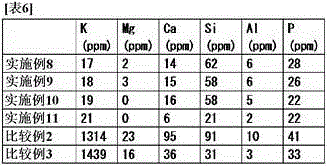Method for purifying plant-derived carbon precursor
A purification method and technology of carbon precursors, applied in the direction of carbon preparation/purification, etc., can solve the problems of difficult removal of phosphorus, difficult stabilization, insufficient removal effect of hydrofluoric acid, etc., achieve good recovery rate and improve quality
- Summary
- Abstract
- Description
- Claims
- Application Information
AI Technical Summary
Problems solved by technology
Method used
Image
Examples
Embodiment 1
[0145] 150 g of small pieces of coconut shells from Mindanao, Philippines, about 10 mm square were immersed in 2000 g of a 7.4% by weight aqueous solution of citric acid, and heated to 90° C. for 3 hours. After cooling to room temperature, the liquid was removed by filtration. This operation was performed three times to perform deliming. The delimed coconut shells were dried under vacuum at 1 Torr at 80°C for 24 hours. The coconut shell pieces purified in this manner were carbonized under the above-mentioned carbonization conditions. The recovery rate of carbide was 28.4%.
Embodiment 2
[0147] In Example 1, carbides were produced in the same manner as in Example 1 except that a 2.4% by weight aqueous acetic acid solution was used. The recovery rate of carbide was 28.6%.
Embodiment 3
[0149] In Example 1, carbides were produced in the same manner as in Example 1 except that a 1.2% aqueous acetic acid solution was used. The recovery rate of carbide was 28.9%.
PUM
| Property | Measurement | Unit |
|---|---|---|
| recovery rate | aaaaa | aaaaa |
Abstract
Description
Claims
Application Information
 Login to View More
Login to View More - R&D
- Intellectual Property
- Life Sciences
- Materials
- Tech Scout
- Unparalleled Data Quality
- Higher Quality Content
- 60% Fewer Hallucinations
Browse by: Latest US Patents, China's latest patents, Technical Efficacy Thesaurus, Application Domain, Technology Topic, Popular Technical Reports.
© 2025 PatSnap. All rights reserved.Legal|Privacy policy|Modern Slavery Act Transparency Statement|Sitemap|About US| Contact US: help@patsnap.com



